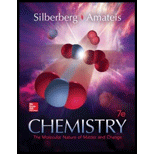
(a)
Interpretation:
Whether the type of force that prevents ice cubes to adopt the shape of the container is intramolecular or intermolecular is to be determined.
Concept introduction:
The phase is defined as the physical state of a substance. The properties of a phase are determined by the interaction of the potential energy
1)
2) Liquid
3) Gas
In gases, the value of kinetic energy
Intramolecular forces operate within a molecule so these properties do not change with change in the phase of a substance. These forces affect the chemical properties of the substance. While intermolecular forces operate between the molecules so changes with change in the phase and effects with physical properties of the substance.
(b)
Interpretation:
Whether the type of force that is overcome when the ice melts is intramolecular or intermolecular is to be determined.
Concept introduction:
The phase is defined as the physical state of a substance. The properties of a phase are determined by the interaction of the potential energy
1) Solid
2) Liquid
3) Gas
In gases, the value of kinetic energy
Intramolecular forces operate within a molecule so these properties do not change with change in the phase of a substance. These forces affect the chemical properties of the substance. While intermolecular forces operate between the molecules so changes with change in the phase and effects with physical properties of the substance.
(c)
Interpretation:
Whether the type of force that is overcome when liquid water is vaporized is intramolecular or intermolecular is to be determined.
Concept introduction:
The phase is defined as the physical state of a substance. The properties of a phase are determined by the interaction of the potential energy
1) Solid
2) Liquid
3) Gas
In gases, the value of kinetic energy
Intramolecular forces operate within a molecule so these properties do not change with change in the phase of a substance. These forces affect the chemical properties of the substance. While intermolecular forces operate between the molecules so changes with change in the phase and effects with physical properties of the substance.
(d)
Interpretation:
Whether the type of force that is overcome when gaseous water is converted to hydrogen gas and oxygen gas is intramolecular or intermolecular is to be determined.
Concept introduction:
The phase is defined as the physical state of a substance. The properties of a phase are determined by the interaction of the potential energy
1) Solid
2) Liquid
3) Gas
In gases, the value of kinetic energy
Intramolecular forces operate within a molecule so these properties do not change with change in the phase of a substance. These forces affect the chemical properties of the substance. While intermolecular forces operate between the molecules so changes with change in the phase and effects with physical properties of the substance.
Want to see the full answer?
Check out a sample textbook solution
Chapter 12 Solutions
Chemistry: The Molecular Nature of Matter and Change - Standalone book
 ChemistryChemistryISBN:9781305957404Author:Steven S. Zumdahl, Susan A. Zumdahl, Donald J. DeCostePublisher:Cengage Learning
ChemistryChemistryISBN:9781305957404Author:Steven S. Zumdahl, Susan A. Zumdahl, Donald J. DeCostePublisher:Cengage Learning ChemistryChemistryISBN:9781259911156Author:Raymond Chang Dr., Jason Overby ProfessorPublisher:McGraw-Hill Education
ChemistryChemistryISBN:9781259911156Author:Raymond Chang Dr., Jason Overby ProfessorPublisher:McGraw-Hill Education Principles of Instrumental AnalysisChemistryISBN:9781305577213Author:Douglas A. Skoog, F. James Holler, Stanley R. CrouchPublisher:Cengage Learning
Principles of Instrumental AnalysisChemistryISBN:9781305577213Author:Douglas A. Skoog, F. James Holler, Stanley R. CrouchPublisher:Cengage Learning Organic ChemistryChemistryISBN:9780078021558Author:Janice Gorzynski Smith Dr.Publisher:McGraw-Hill Education
Organic ChemistryChemistryISBN:9780078021558Author:Janice Gorzynski Smith Dr.Publisher:McGraw-Hill Education Chemistry: Principles and ReactionsChemistryISBN:9781305079373Author:William L. Masterton, Cecile N. HurleyPublisher:Cengage Learning
Chemistry: Principles and ReactionsChemistryISBN:9781305079373Author:William L. Masterton, Cecile N. HurleyPublisher:Cengage Learning Elementary Principles of Chemical Processes, Bind...ChemistryISBN:9781118431221Author:Richard M. Felder, Ronald W. Rousseau, Lisa G. BullardPublisher:WILEY
Elementary Principles of Chemical Processes, Bind...ChemistryISBN:9781118431221Author:Richard M. Felder, Ronald W. Rousseau, Lisa G. BullardPublisher:WILEY





